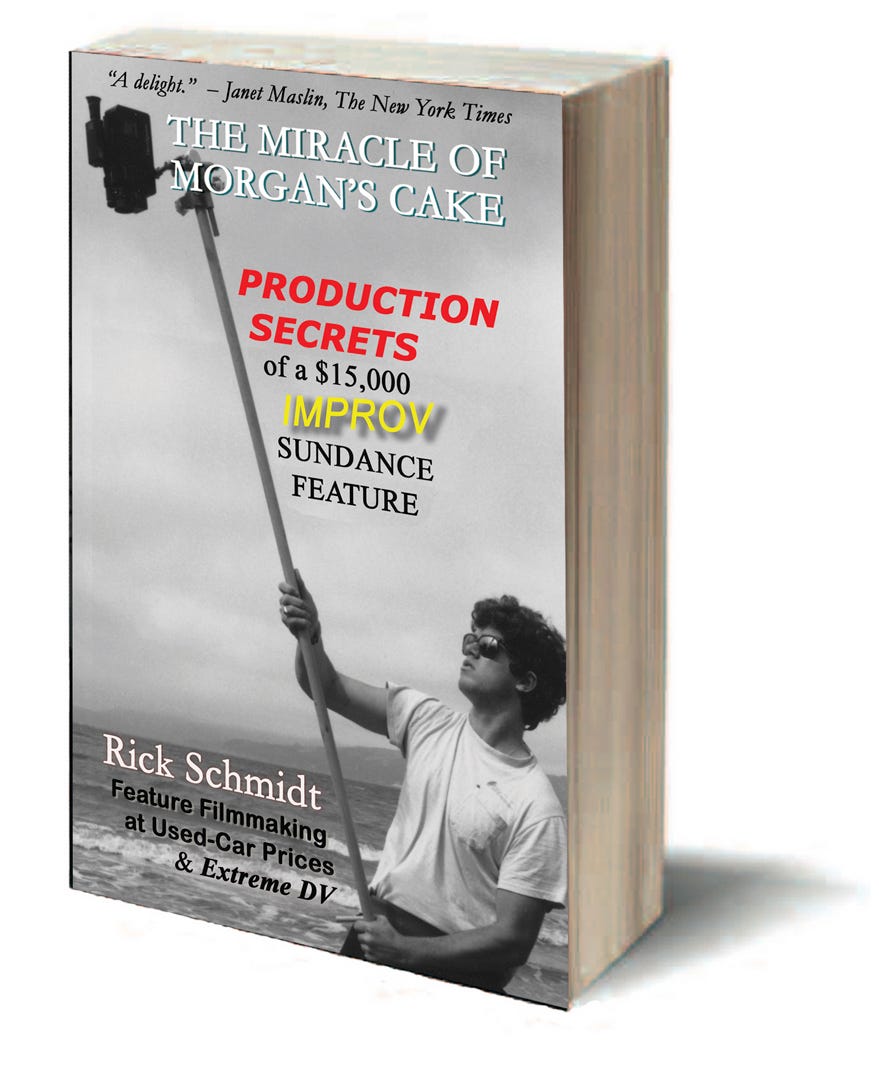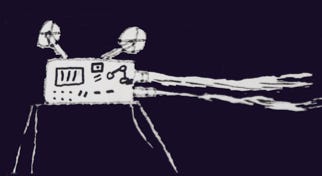Featuring another "how-to" film book--how MORGAN'S CAKE production finally came together after I had NO $, NO equipment (or good ideas...) to shoot! Enjoy this case-study. "A delight"––NY Times.
SEE FULL MORGAN'S CAKE FEATURE: <https://vimeo.com/168153085>
(Excerpted from THE MIRACLE OF MORGAN'S CAKE––Production Secrets of a $15,000 IMPROV Sundance Feature").
INTRODUCTION
In the pages ahead I hope to shed some light on the DV moviemaking process, explaining how to flow with the creation of a story using all available opportunities for scene-making. In many ways, my approach to shooting and producing Morgan’s Cake on 16MM compares to the open system of flowing a movie in DV.
Morgan’s Cake was shot in nine days in 1987, for a filmstock, processing and work printing cost of approximately $4,500, with another $2000 or so going to salaries and food for cast and crew (total budget of $15,000 by the time a professional sound mix, sound inter-negative and print costs were added), and it ended up premiering at several of the top film festivals in the world, including Sundance’s Dramatic Competition, New Directors/New Films in New York City, Berlin International (Panorama), San Francisco International etc. How did I manage to produce my movie on expensive film stock for less than many DV features cost?
For starters, I was able to shoot Morgan’s Cake (and most of my other features) at basically a one-to-one ratio. I shot everything only once except when an obvious mistake forced a second take. As you gain confidence you will want to seriously consider incorporating this one-to-one shooting approach, which saves a great deal of time during the on-location shoot and later is a huge plus during editing (much less footage to cut!
This book is ultimately about taking a zen-like approach, reaching a state where you can flow comfortably through the writing, directing, and editing. BUT, if the shoot hasn't delivered all the structural components then you'll fix it in the editing, creating some original effects and new footage to utilize so-called “mistakes.” With the right mind-set anything is possible.
Conception of Morgan's Cake (Getting Started)
Sometimes it takes the constant prodding of another person to actually get moving forward with your dream of making a feature-length movie. In the case of Morgan’s Cake it took the persistent urging of my then 17-year-old son, Morgan, to get me started. Over the course of production of my first three features, A Man, a Woman, and a Killer (Morgan was six years old when it was completed), Showboat 1988-The Remake (Morgan turned nine), and Emerald Cities (Morgan at fourteen), Morgan and his two sisters had seen a lot of the moviemaking process. As little kids they had spent considerable time in my little cubby-hole editing room at the now-defunct Palmer Films lab in San Francisco, and had sat around patiently for hours while I screened everything from rough footage to the latest fine-cut in the lab's screening room. And they’d been with me after the prints had finally been struck and were locally screened in all their 16mm glory, at San Francisco theaters like the Larkin, Electric, and the cavernous Strand Theatre on Market street.
At the Larkin premiere, where Showboat 1988-The Remake toured as one of the prize winners of the Ann Arbor Film Festival, a telling “Morgan” incident occurred. At some point during the screening, the theatre manager approached me and complained that a little boy was bothering people, running all over the theatre, up and down the aisles, tapping people on the shoulder and describing in detail what scenes were coming up next: “The nun takes her clothes off after she dances with her dog...and then a guy jumps over flaming swords.” At nine years old, Morgan, veteran of countless screenings, had inadvertently memorized the scenes and order of the assembly and wanted to share his discoveries.
Morgan (14), and Heather (16) had also attended Strand Theatre's San Francisco premiere of my post-punk rock extravaganza, Emerald Cities, where bands Flipper and The Mutants performed live after the screening (members of both bands were friends of mine from California College of the Arts art-school days). Anyway, it was a star-studded affair, with hundreds of punks there to see the movie and hear the two bands shouting their lyrics over the super-powered A-2 speakers. In the movie, the songs have subtitles, but these fans knew the lyrics by heart. At any rate, I suppose just attending that one screening would have been enough to convince Morgan that moviemaking was a thrill-ride worth taking.
And so 17-year-old Morgan continued to nag me, Let’s make a movie together, Dad! A few weeks would go by and I’d hear it again. Maybe me and my friends could act...I had no money, in fact still owed the lab thousands from finishing Emerald Cities, so I couldn't imagine making a new feature anytime soon. But Morgan was indomitable. We can do it!
Scripting/Conceptualizing
Around this time (Fall, 1986), I had recently completed the manuscript for my how-to filmmaking book, Feature filmmaking at Used-Car Prices which discussed the traditional steps of creating the basic three-act script, with a hint of using some improvisational styles for the final writing form and shooting process. In the book I’d explained that aside from being just a series of descriptive paragraphs and dialogue to match (traditional format), a script could consist of a more journalistic-style compilation. But my scripting was slow coming for the “Morgan” movie. Instead of remaining frustrated, I decided at Morgan’s urging to just try and shoot something – anything – with inexpensive video. Maybe seeing some images, hearing some teenage dialogue would spur me on.
Here’s how Morgan, age nine, depicted my films being projected – bolts of fire and brimstone spewing forth! Years later, I incorporated his drawing in a flier for two home town premieres.
So I latched onto Morgan's dream, deciding to shoot some conversations with him and his best friend Leon Kenin using a Hi-8 video camera borrowed from artist friend Elizabeth Sher. The most pressing topic was having to register for the draft when he turned 18. Leon added his astute point-counterpoint remarks, mainly about the problem of forfeiting college loans – Morgan wouldn't be qualified without being registered for the draft. From there they went on to discuss attending college (or not), getting jobs, the high-cost of student housing in 1986, girlfriends, etc. While they had enjoyed the attention, being on-camera, I had felt relieved to be back in the filmmaking saddle again.
The video footage looked pretty good, though sound quality was less than perfect, buffeted by the windy conditions that day. But it was clear that the boys were “naturals.” I learned that given the chance, they could offer some important truths about the teenage experience.
So I had my young male leads selected -- call it “casting.” But I still didn’t feel that a story concept was totally in place for a full-length feature (75- 90 minutes). There was no real bite, no over-arching development and known climax to a story, some structure that would help me write and direct with a sense of purpose. But I was beginning to appreciate working with my son. He seemed to be a devoted Associate Producer and a tireless actor/performer. And it was obvious that he wasn’t the least bit shy about delivering lines off the top of his head. His friend Leon also shared this same self-possessed confidence (Leon landed at Princeton University a year later).
Most importantly, I was spending some quality time with my kid, and that had been something previously lacking in my life. So aside from not yet having a solid conceptual core for the “Morgan” movie, I was happy to encourage our evolving relationship. But as months went by we made no new moviemaking progress. It didn't seem that I was getting any smarter waiting for some breakthrough concept to come and smack me over the head. So with no apparent direction in mind, I again borrowed my friend Liz Sher’s Hi-8 camera and decided to just hit the streets of Berkeley, maybe shooting various people talking about registering for the draft. I figured I would ask some “regular folks” to voice their draft-related comments to the video camera, if they agreed to sign an Actor’s Release form which granted me permission to use the results in a movie “tentatively entitled Morgan.”
Driving around in Berkeley I spotted a lone black man walking alone along University Avenue, in the no-man’s land halfway between San Pablo Avenue and Shattuck Avenue. What about him? I wondered. I was crazy enough to stop the car along the curb and call out my invitation to be in a video. For some reason he agreed. I hopped out and presented the Actor’s Release form, on which he quickly scrawled his name. Then I gave him some instructions. I told him, Look at and talk to the camera lens as if it were Morgan’s eyes. I beseeched him to give Morgan (the camera) his truthful advice about whether or not to register for the draft. And Tell Morgan a personal draft story if you have one, I hurriedly added.
As he spoke to the small Hi-8 camera his eyes darted back and forth, up and down University Avenue, as if on the lookout for something or someone who threatened him. I picked up on his nervous intensity and made some radical camera moves, crossing his path when he shifted location on the sidewalk, shooting directly into the sun before I could pull his image back into focus. Shooting basically for just as long as the scene ran – three minutes or so – was enough to record his statement before he hurried on down the Avenue.
Returning home I excitedly viewed the footage and was struck by the power of the man’s words and his direct delivery. He told of his two brothers who had died in Vietnam, but that he was prepared to go to jail as a conscientious objector. Anyway, it was great stuff. Fortunately, before that video taping I had purchased a cheap $60 Sony directional microphone for Liz’s camera, which enabled me to record dialogue cleanly (my left hand kept the mike aimed directly at the speaker's mouth, while the right hand held the camera). And perhaps it was just my filmmaker’s reflex to bother with getting a signed Actor’s Release at that early stage in the process, but that producer-driven decision enabled me to include that great curbside interview in the final version of Morgan's Cake (click movie name to see the Hi-8 video footage here in TRAILER. It was transferred to 16mm at a cost of $50/minute).
So with my desperate video excursion I had moved the production one huge step forward, overcoming my low-energy roadblocks (no money, no well-scripted ideas...), to began thinking more positively about making a new work.
———--






It's hard to overstate the importance of this feature of your Features: Going into a setting, a scene, with one or more "actors," with "no well-scripted ideas." Just BE-ing, letting what happens ... happen.
No money no ideas no clue. Sounds like a current problem. The gear issue has sure changed tho huh lol